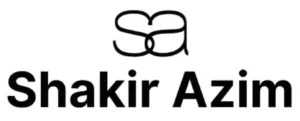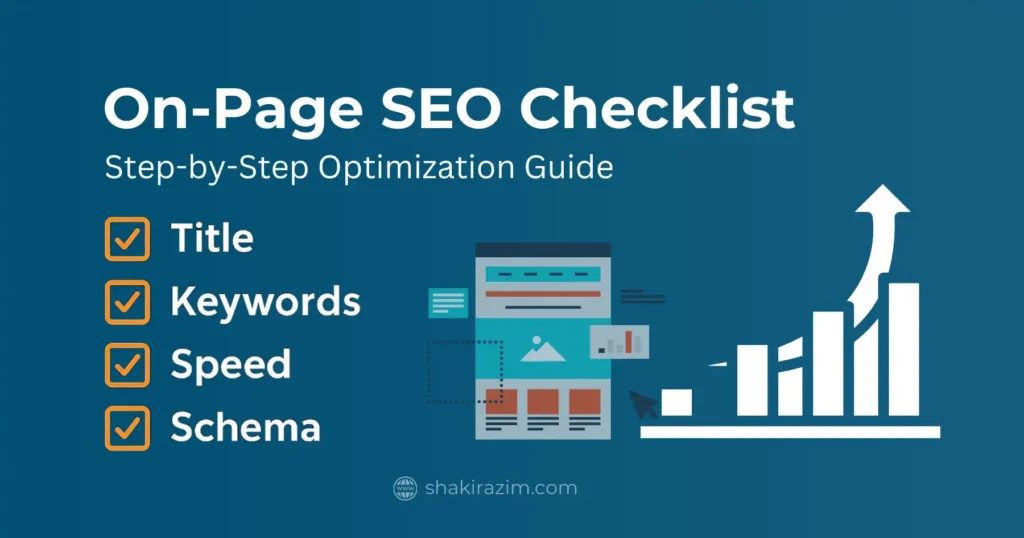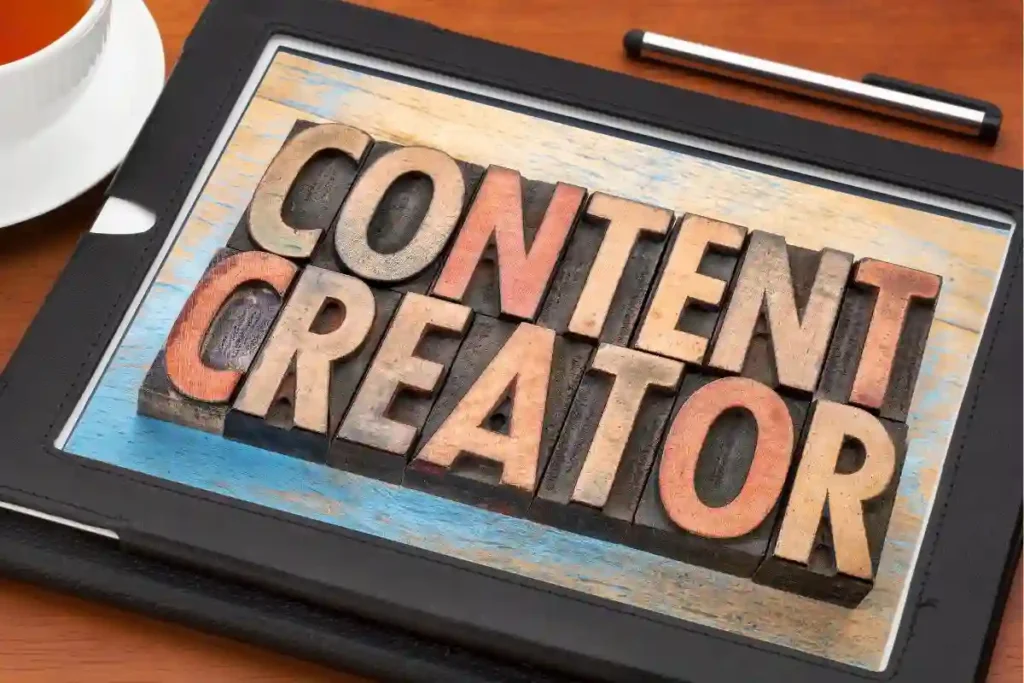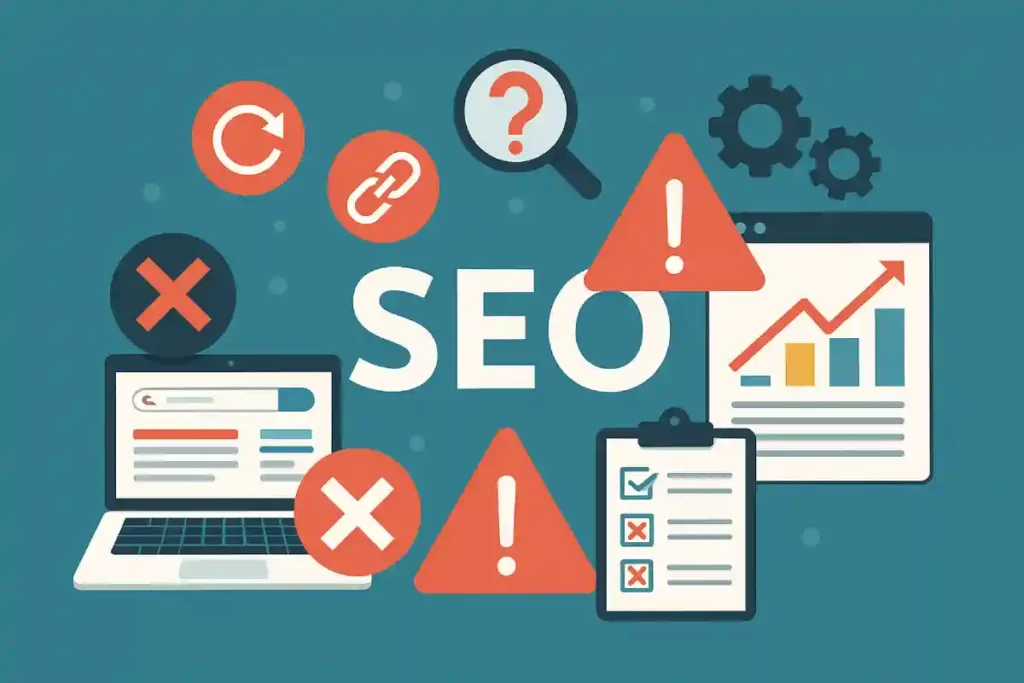Looking for the ultimate On-Page SEO Checklist 2025? You’re in the right place. In 2025, search has changed with AI Overviews, GEO (Generative SEO), and trust-based ranking factors—but the fundamentals of on-page SEO are still the foundation of visibility. This step-by-step guide will walk you through titles, meta descriptions, headings, keywords, images, links, and GEO-friendly optimization so every blog post you publish ranks higher and builds long-term authority.
Why On-Page SEO Still Matters in 2025
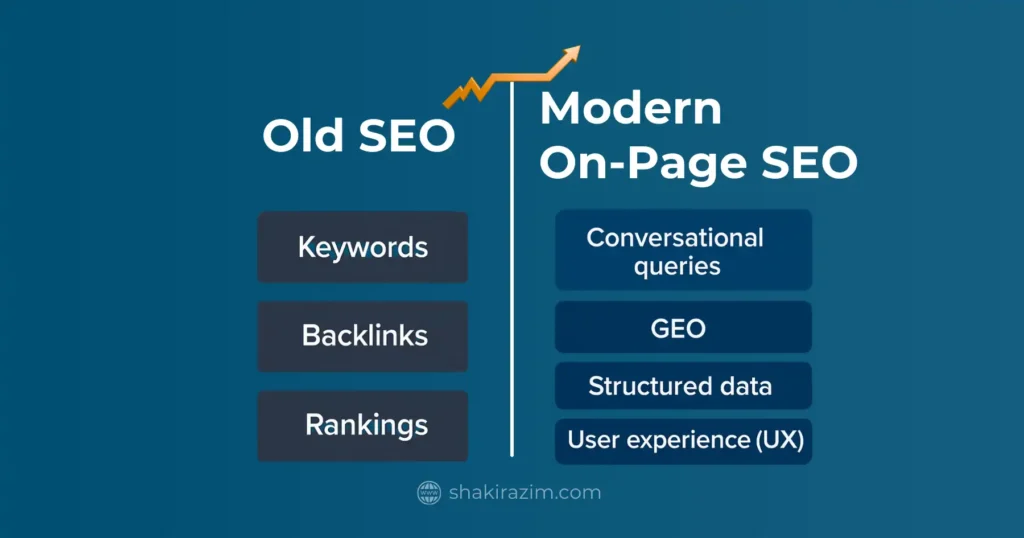
If you’ve been hearing that “SEO is dead” because of AI Overviews or ChatGPT search, don’t believe it. The truth is → on-page SEO is more important than ever.
Here’s why:
- Google still needs structured, well-optimized content to understand your page.
- AI Overviews and generative engines prefer clear formatting, headings, and lists when citing answers.
- Users leave fast if your content looks messy or hard to read.
In other words: while SEO is evolving (Generative SEO, AI-driven search, brand trust), the fundamentals of on-page optimization are the foundation.
This checklist will guide you step by step to make sure every blog post you publish in 2025 is fully optimized for search engines, AI assistants, and—most importantly—your readers.
(If you’re new here, this post supports my main SEO & Digital Growth Guide – Strategies for 2025 and Beyond. Make sure to read that too for the full roadmap.)
What is On-Page SEO?
On-page SEO refers to all the optimizations you make within your website pages so search engines (and users) understand them better.
It includes things like:
- Title tags
- Meta descriptions
- Headings (H1, H2, H3)
- Keyword placement
- Image optimization
- Internal and external linking
- Content formatting
👉 You can think of on-page SEO as the structural framework of your website. Just like a house needs a solid foundation before decorating, your content needs strong on-page SEO before off-page and technical work can have full impact.
Quick comparison:
- On-Page SEO = what you do on your site (content, keywords, structure).
- Off-Page SEO = what happens outside your site (backlinks, social signals).
- Technical SEO = how your site performs (speed, mobile, crawling).
The On-Page SEO Checklist 2025
Now let’s get into the step-by-step checklist.
1. Title Tags & Meta Descriptions
Your title tag is the main text users see in search engine results.
Your meta description is the short snippet displayed under it.
Best practices in 2025:
- Place your focus keyword early (example: On-Page SEO Checklist 2025).
- Keep the title under 60 characters.
- Keep meta description under 160 characters.
- Make it compelling → encourage clicks, not just keyword-stuffed.
- Include the year (2025) for freshness.
💡 Example:
- Title: On-Page SEO Checklist 2025 – Step-by-Step Guide
- Meta: Learn the complete On-Page SEO Checklist 2025. A practical guide to optimizing titles, headings, keywords, images, and schema for higher rankings.
2. Headings & Content Structure
Headings (H1, H2, H3) are not just for design—they help both Google and AI Overviews understand your content hierarchy.
Checklist for 2025:
- Use only one H1 (the page title).
- Use H2 for major sections, H3 for sub-sections.
- Make sure your main keyword appears in at least one H2 heading.
- Keep sections short and scannable.
💡 Example:
- H1 → On-Page SEO Checklist 2025
- H2 → Title Tags & Meta Descriptions
- H3 → How to write SEO titles
3. Keyword Placement & Density
Gone are the days of keyword stuffing. Google now understands topics and context. Over-optimization is one of the common SEO mistakes that still hurt rankings today.
👉 Here’s a complete guide on on-page SEO from Ahrefs.
In 2025, here’s how to use keywords:
- Use your focus keyword in:
- Title tag
- First 100 words
- At least 1 H2
- Conclusion
- Use supporting keywords naturally throughout.
- Don’t over-optimize. Aim for 1–2% density (about 10–15 mentions in a 1,500–2,000 word post).
💡 Example: Instead of repeating On-Page SEO Checklist 2025 everywhere, use:
- On-page SEO guide
- SEO checklist for bloggers
- SEO optimization steps
4. Internal & External Links
Links are the roadmap that connects your content.
Internal links → point to your own posts.
External links → point to trusted resources.
Best practices in 2025:
- Add 3–5 internal links to related posts.
- Example: Link to your pillar blog (SEO & Digital Growth Guide).
- Add 2–3 external links to authority sites (Google, Moz, Ahrefs).
- Use descriptive anchor text, not “click here.”
💡 Example: Instead of: Read this blog [click here]
Use: Read my full SEO & Digital Growth Guide 2025.
5. Image Optimization
Images are often overlooked—but both Google Images and AI assistants pull from them.
Checklist:
- File name: use focus keyword (e.g.,
on-page-seo-checklist-2025.png). - Alt text: describe clearly (e.g., “On-Page SEO Checklist 2025 infographic”).
- Title: short & descriptive.
- Compress images for fast load (WebP is best).
- Use infographics & visuals where possible.
💡 Example: Add a simple infographic summarizing this checklist → perfect for SEO + shareability.
6. Schema Markup
Schema markup is extra code that provides structured context to search engines about your content.
👉 Moz explains on-page ranking factors in detail.
What to use in 2025:
- FAQ Schema → Add FAQs at the end.
- Article Schema → Helps Google understand your blog.
- How-To Schema (if step-based).
Tools like Rank Math make this easy in WordPress.
7. UX & Engagement Signals
Google now looks at user behavior as ranking signals.
Focus on:
- Page speed (under 2s).
- Mobile responsiveness (most searches are mobile).
- Readability (short paragraphs, bullet points, clear fonts).
- Add interactive elements (polls, videos, infographics).
👉 If users stay longer, scroll, and share → Google sees your page as valuable.
Bonus – GEO-Friendly On-Page SEO
Since Generative SEO (GEO) is shaping the future, optimize your content so AI Overviews pick it up.
Checklist:
- Add FAQs with direct Q&A format.
- Use bullet lists & tables (AI loves structured content).
- Cite sources when adding stats.
- Show author expertise → add bio with links to your LinkedIn/Scholar.
On-Page SEO Tools for 2025
Here are some tools that can help you implement this checklist:
Free Tools:
- Google Search Console
- Google Analytics 4
- Rank Math (SEO plugin)
Paid Tools:
- SurferSEO (content optimization)
- Clearscope (semantic keyword analysis)
- Ahrefs/Semrush (keyword + link tracking)
Conclusion – Your On-Page SEO Roadmap
On-page SEO in 2025 is not complicated. It’s about making your content easy to understand for:
- Readers
- Search engines
- AI assistants
Follow this checklist and every blog post you write will be search-friendly, GEO-ready, and future-proof.
As Search Engine Journal highlights, following SEO best practices ensures long-term results.
👉 For a complete SEO strategy that goes beyond on-page optimization, read my full SEO & Digital Growth Guide – Strategies for 2025 and Beyond.
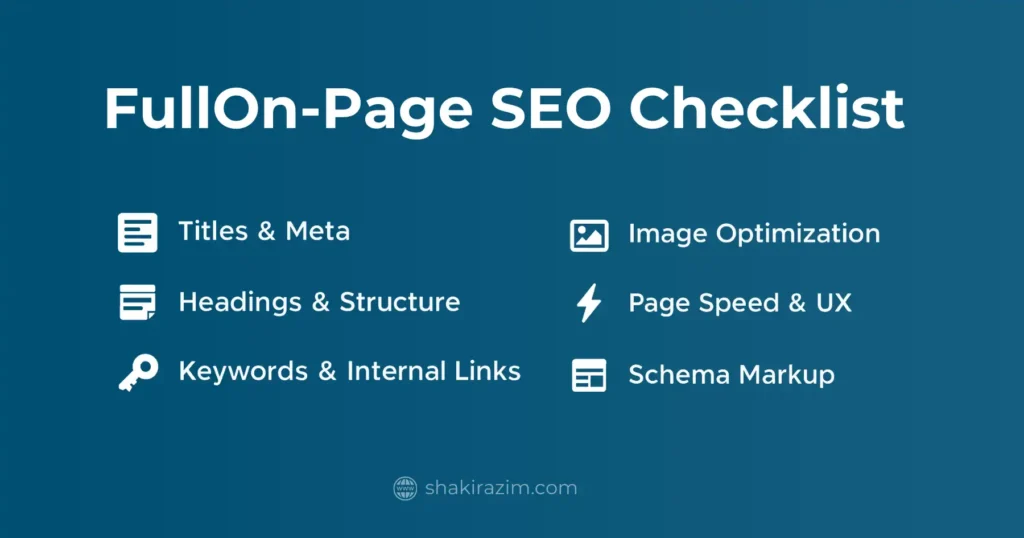
FAQ – On-Page SEO Checklist 2025
Q1: What is on-page SEO?
On-page SEO is the practice of optimizing individual web pages for search visibility. It includes titles, headings, keywords, images, and internal linking.
Q2: What’s the difference between on-page and off-page SEO?
On-page = changes within your site (content, keywords).
Off-page = external signals (backlinks, brand mentions).
Q3: How often should I update on-page SEO?
At least every 6–12 months. Update titles, content, and stats yearly (e.g., 2025 → 2026).
Q4: Does on-page SEO matter with AI search?
Yes. AI Overviews and ChatGPT rely on structured, trustworthy, optimized content.
Q5: Do I need tools for on-page SEO?
Not necessarily. Free tools like Google Search Console + Rank Math are enough to start. Paid tools help scale.
